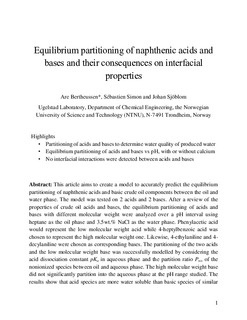| dc.contributor.author | Bertheussen, Are | |
| dc.contributor.author | Simon, Sebastien Charles | |
| dc.contributor.author | Sjøblom, Johan | |
| dc.date.accessioned | 2018-02-02T14:24:57Z | |
| dc.date.available | 2018-02-02T14:24:57Z | |
| dc.date.created | 2017-10-17T16:26:27Z | |
| dc.date.issued | 2017 | |
| dc.identifier.citation | Colloids and Surfaces A: Physicochemical and Engineering Aspects. 2017, 529 45-56. | nb_NO |
| dc.identifier.issn | 0927-7757 | |
| dc.identifier.uri | http://hdl.handle.net/11250/2482464 | |
| dc.description.abstract | This article aims to create a model to accurately predict the equilibrium partitioning of naphthenic acids and basic crude oil components between the oil and water phase. The model was tested on 2 acids and 2 bases. After a review of the properties of crude oil acids and bases, the equilibrium partitioning of acids and bases with different molecular weight was analyzed over a pH interval using heptane as the oil phase and 3.5 wt.% NaCl as the water phase. Phenylacetic acid would represent the low molecular weight acid while 4-heptylbenzoic acid was chosen to represent the high molecular weight one. Likewise, 4-ethylaniline and 4-decylaniline were chosen as corresponding bases. The partitioning of the two acids and the low molecular weight base was successfully modelled by considering the acid dissociation constant pKa in aqueous phase and the partition ratio Pwo of the non-ionized species between oil and aqueous phase. The high molecular weight base did not significantly partition into the aqueous phase at the pH range studied. The results show that acid species are more water soluble than basic species of similar molecular weight. In presence of calcium the partitioning of acids is successfully modelled by accounting for the precipitation of naphthenate soap with a solubility constant Ks. The kinetic interfacial tension between heptane and 3.5% NaCl aqueous buffer was also analyzed with oils that contained single compounds, two bases, two acids and all four components over a pH interval to identify any interfacial acid-base interactions. No significant interfacial interaction could be identified, mostly due to similar pKa values. | nb_NO |
| dc.language.iso | eng | nb_NO |
| dc.publisher | Elsevier | nb_NO |
| dc.rights | Attribution-NonCommercial-NoDerivatives 4.0 Internasjonal | * |
| dc.rights.uri | http://creativecommons.org/licenses/by-nc-nd/4.0/deed.no | * |
| dc.title | Equilibrium partitioning of naphthenic acids and bases and their consequences on interfacial properties | nb_NO |
| dc.type | Journal article | nb_NO |
| dc.type | Peer reviewed | nb_NO |
| dc.description.version | acceptedVersion | nb_NO |
| dc.source.pagenumber | 45-56 | nb_NO |
| dc.source.volume | 529 | nb_NO |
| dc.source.journal | Colloids and Surfaces A: Physicochemical and Engineering Aspects | nb_NO |
| dc.identifier.doi | 10.1016/j.colsurfa.2017.05.068 | |
| dc.identifier.cristin | 1505335 | |
| dc.relation.project | Norges forskningsråd: 237893 | nb_NO |
| dc.description.localcode | © 2017. This is the authors’ accepted and refereed manuscript to the article. Locked until 26.5.2019 due to copyright restrictions. This manuscript version is made available under the CC-BY-NC-ND 4.0 license http://creativecommons.org/licenses/by-nc-nd/4.0/ | nb_NO |
| cristin.unitcode | 194,66,30,0 | |
| cristin.unitname | Institutt for kjemisk prosessteknologi | |
| cristin.ispublished | true | |
| cristin.fulltext | original | |
| cristin.fulltext | postprint | |
| cristin.qualitycode | 1 | |

